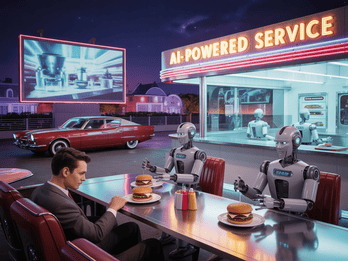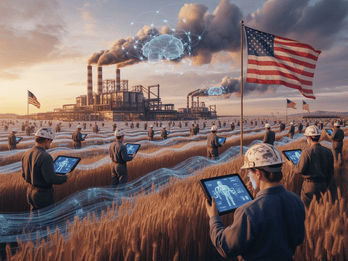An analysis of the latest developments in artificial intelligence from Peter Diamandis’s WTF podcast featuring AI expert Alex Wissner-Gross
The artificial intelligence landscape is evolving at breakneck speed, with nations, corporations, and individuals racing to claim dominance in what many are calling the most significant technological shift since the internet. A recent episode of Peter Diamandis’s “What the Future” podcast, featuring MIT polymath Alex Wissner-Gross and venture capitalist Dave Blundin, offers crucial insights into where we stand in 2025 and what’s coming next.
The Scale of the AI Arms Race
The numbers being thrown around in AI development today are staggering. Elon Musk’s xAI has already doubled its Colossus supercomputer from 100,000 to 200,000 H100 GPUs in just three months, with plans for Colossus 2 to feature the equivalent of 5.5 million H100s. His ultimate goal? 50 million H100 equivalents within five years – representing roughly a trillion dollars in today’s GPU prices.
Not to be outdone, OpenAI announced they’ll cross well over 1 million GPUs by the end of 2025, while Meta is constructing Manhattan-sized data centers in hurricane-proof tents to accelerate deployment. As Wissner-Gross notes, “There’s no precedent in history for what’s about to happen. Everyone always compares it to the internet explosion of growth, but this is so much bigger.”
America’s AI Action Plan: A War Footing

President Trump’s recently unveiled AI Action Plan represents what Wissner-Gross calls “potentially the broadest US industrial strategy since President Eisenhower’s interstate highway system.” The plan operates on three key pillars:
- Regulatory Acceleration: Rescinding old regulations and reviewing state-level rules that slow AI development
- Infrastructure Streamlining: Fast-tracking data centers, chip factories, and energy projects
- Strategic Exports: Securing data centers for military use and exporting US AI technology to allies
The plan requires no congressional approval – it’s happening via executive order. This represents a fundamental shift toward treating AI development as a national security imperative, with Wissner-Gross drawing parallels to Niels Bohr’s comment about the Manhattan Project: turning the entire country into “one huge factory.”
The Talent War: $100 Million Salaries and Beyond
The competition for AI talent has reached unprecedented levels. Meta’s recent hiring spree for their super intelligence team included offers reportedly reaching $100 million to $1 billion for top researchers. The team’s composition tells a story about global AI talent:
- 50% have origins in China
- 40% were poached from OpenAI
- 20% came from DeepMind
- 75% hold PhDs
Jensen Huang of Nvidia claims to have “created more billionaires on my management team than any CEO in the world,” highlighting how the AI boom is creating wealth at an unprecedented scale. As the podcast notes, we’re seeing a preview of “post-scarcity individual economics” where individuals controlling enormous compute resources command compensation in the hundreds of millions.
Mathematical Breakthroughs: AI Solves the Impossible
Perhaps the most significant recent development is AI’s performance on the International Mathematical Olympiad (IMO). Both OpenAI and Google’s DeepMind achieved gold medal performance, solving five out of six world-class mathematical problems. This represents a watershed moment that Wissner-Gross argues indicates we’re “most of the way towards math being solved.”
What makes this particularly remarkable is that these solutions were generated entirely in natural language – no formal mathematical notation required. This suggests that solving humanity’s grand challenges in disease, energy, and physics may not require the formal systems many expected, but could emerge from natural language reasoning at scale.
Energy: The Ultimate Bottleneck

While much attention focuses on chip shortages, the real constraint may be energy. China has installed 464 gigawatts of solar capacity in just the last 12 months, essentially “covering their countryside in solar.” Meanwhile, the US remains focused on slower-deploying nuclear and geothermal solutions.
The data centers powering AI require continuous power – they can’t simply be turned off at night because the chips are too expensive to leave idle. This has led to innovative solutions like using Tesla vehicles as distributed energy storage, with Elon Musk envisioning millions of Teslas providing backup power to the grid.
The Browser Wars Return
The competition isn’t limited to model development. OpenAI is preparing to launch a web browser challenging Google Chrome, while Perplexity has introduced Comet, an AI-powered browser that reimagines how we interact with information online.
Google’s search dominance faces an existential threat as AI overviews now serve over 2 billion users monthly, yet this success paradoxically threatens their core advertising model. As more queries are answered directly by AI rather than requiring clicks to external sites, the fundamental economics of web advertising may need complete reimagining.
What “Solving Physics” Really Means
Wissner-Gross’s prediction that AI will “solve physics” within years sounds like science fiction, but he’s specific about what this means: achieving superhuman performance in both theoretical and experimental physics research. Given that we haven’t seen major fundamental physics breakthroughs in half a century, AI may represent our best shot at unlocking new physics.
The implications are staggering. Beyond fusion power, solved physics could mean gravity shielding, manipulation of spacetime, and energy sources that make current technology look primitive. As Wissner-Gross notes, “If we solve physics in the next few years, we could be building micro black holes and harvesting Hawking radiation.”
The Path to Recursive Self-Improvement
Currently, AI is writing 50% of Google’s code, 25% of Amazon’s, and similar percentages across major tech companies. This trend points toward what may be the most significant milestone: recursive self-improvement, where AI begins rewriting and improving its own code.
The safety implications are serious, but as Dave Blundin argues, straightforward guardrails can prevent AI from creating its own objectives while still capturing all the benefits. The key insight is that preventing AI from becoming autonomous doesn’t require slowing progress – it just requires maintaining human oversight of goal-setting.
Looking Ahead: The Day After Super Intelligence
While much of the AI discourse focuses on reaching artificial general intelligence (AGI), Wissner-Gross spends considerable time thinking about “the day after super intelligence.” His vision includes AI solving not just individual problems but entire fields: mathematics, physics, chemistry, biology, and medicine.
This isn’t just about making incremental improvements – it’s about unlocking solutions to humanity’s grand challenges at unprecedented scale. We may soon see AI cure diseases, solve energy problems, and discover new physics that opens up possibilities we can barely imagine today.
The Bottom Line
We’re witnessing the early stages of the most significant technological transformation in human history. The scale of investment, the pace of development, and the potential implications dwarf previous technological revolutions. As Wissner-Gross notes, we may already be five years into the AGI era without fully realizing it.
The question isn’t whether this transformation will happen – it’s already underway. The question is which nations, companies, and individuals will be positioned to benefit from and help shape this transformation. Based on current trends, we may have our answers sooner than anyone expects.
The pace of change means that by the time you finish reading this analysis, several new developments will have likely emerged. As the podcast participants repeatedly emphasize: don’t blink, because it’s moving that fast.

